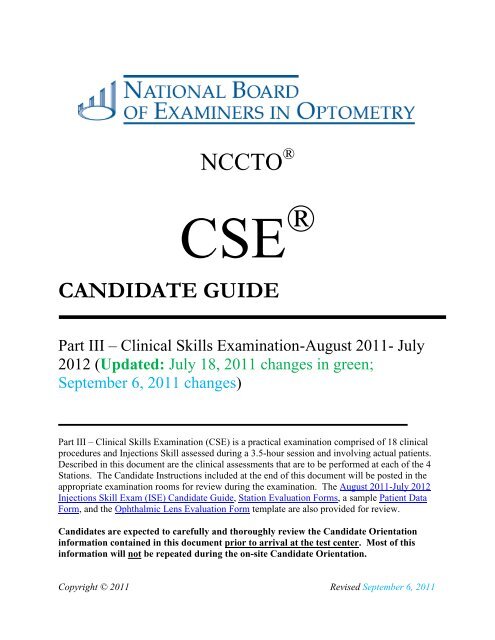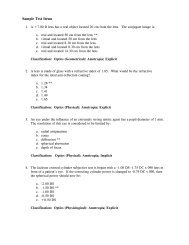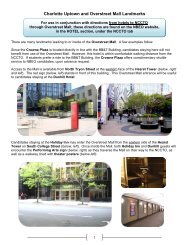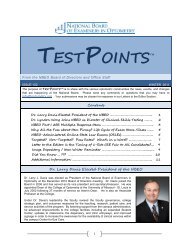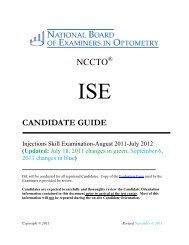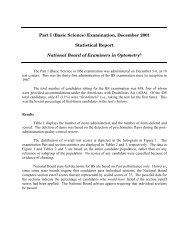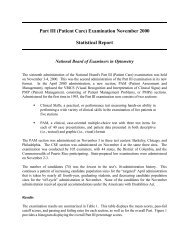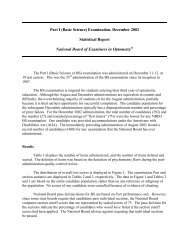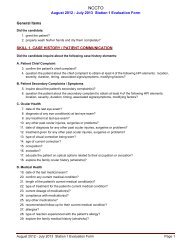Clinical Skills - National Board of Examiners in Optometry
Clinical Skills - National Board of Examiners in Optometry
Clinical Skills - National Board of Examiners in Optometry
You also want an ePaper? Increase the reach of your titles
YUMPU automatically turns print PDFs into web optimized ePapers that Google loves.
NCCTO ®<br />
CSE ®<br />
CANDIDATE GUIDE<br />
Part III – <strong>Cl<strong>in</strong>ical</strong> <strong>Skills</strong> Exam<strong>in</strong>ation-August 2011- July<br />
2012 (Updated: July 18, 2011 changes <strong>in</strong> green;<br />
September 6, 2011 changes)<br />
Part III – <strong>Cl<strong>in</strong>ical</strong> <strong>Skills</strong> Exam<strong>in</strong>ation (CSE) is a practical exam<strong>in</strong>ation comprised <strong>of</strong> 18 cl<strong>in</strong>ical<br />
procedures and Injections Skill assessed dur<strong>in</strong>g a 3.5-hour session and <strong>in</strong>volv<strong>in</strong>g actual patients.<br />
Described <strong>in</strong> this document are the cl<strong>in</strong>ical assessments that are to be performed at each <strong>of</strong> the 4<br />
Stations. The Candidate Instructions <strong>in</strong>cluded at the end <strong>of</strong> this document will be posted <strong>in</strong> the<br />
appropriate exam<strong>in</strong>ation rooms for review dur<strong>in</strong>g the exam<strong>in</strong>ation. The August 2011-July 2012<br />
Injections Skill Exam (ISE) Candidate Guide, Station Evaluation Forms, a sample Patient Data<br />
Form, and the Ophthalmic Lens Evaluation Form template are also provided for review.<br />
Candidates are expected to carefully and thoroughly review the Candidate Orientation<br />
<strong>in</strong>formation conta<strong>in</strong>ed <strong>in</strong> this document prior to arrival at the test center. Most <strong>of</strong> this<br />
<strong>in</strong>formation will not be repeated dur<strong>in</strong>g the on-site Candidate Orientation.<br />
Copyright © 2011 Revised September 6, 2011
August 2011-July 2012 Candidate Orientation Information Posted on the NBEO ®<br />
Website<br />
Candidate Orientation Information: General<br />
The <strong>Cl<strong>in</strong>ical</strong> <strong>Skills</strong> Exam<strong>in</strong>ation (CSE) beg<strong>in</strong>s with an on-site orientation that all Candidates are required to attend.<br />
Candidates who are late for the orientation will be disqualified from that exam<strong>in</strong>ation session. A Candidate who arrives<br />
late will be scheduled for a subsequent exam<strong>in</strong>ation session dur<strong>in</strong>g the same day if possible. However, space and time<br />
constra<strong>in</strong>ts may prevent a Candidate from be<strong>in</strong>g rescheduled to a later session, and, <strong>in</strong> that event, the Candidate forfeits<br />
his/her right to be<strong>in</strong>g tested dur<strong>in</strong>g that adm<strong>in</strong>istration <strong>of</strong> CSE. The on-site Candidate Orientation complements the<br />
<strong>in</strong>formation conta<strong>in</strong>ed <strong>in</strong> this document.<br />
A video record<strong>in</strong>g will be presented for the Candidate Orientation at the <strong>National</strong> Center <strong>in</strong> <strong>Cl<strong>in</strong>ical</strong> Test<strong>in</strong>g <strong>of</strong> <strong>Optometry</strong><br />
(NCCTO). NCCTO staff member will serve as the Candidate advocate to assist with any problems that may arise.<br />
IDENTIFICATION FORM REQUIRED<br />
To be admitted to the test center, you must present an acceptable form <strong>of</strong> picture identification that <strong>in</strong>cludes both a<br />
photograph and a signature. The only acceptable forms <strong>of</strong> identification are:<br />
<br />
<br />
<br />
<br />
A valid driver’s license or an <strong>of</strong>ficial photo ID issued by the government <strong>of</strong> the state or prov<strong>in</strong>ce where you reside.<br />
A valid passport.<br />
A valid student identification card from an accredited school or college <strong>of</strong> optometry, provided this ID card <strong>in</strong>cludes<br />
both a photograph and signature embedded <strong>in</strong> the card.<br />
In order to be considered valid, the ID must match the name on the roster for the exam. If the name does not<br />
match, a Candidate may be denied access to the exam. To submit a name change, click here:<br />
https://www.optometry.org/pdf/namechange.pdf. Your onl<strong>in</strong>e pr<strong>of</strong>ile (https://www.optometry.org/pr<strong>of</strong>ile/ ) will be<br />
updated once the NBEO records are updated.<br />
ID Forms from membership organizations or clubs are not permissible for admission to any <strong>National</strong> <strong>Board</strong> test.<br />
Candidates must know their NBEO website User ID and Password (needed to complete the onl<strong>in</strong>e Incident/ Survey Report<br />
at the test center).<br />
Candidates are expected to wear pr<strong>of</strong>essional attire. Use “bus<strong>in</strong>ess casual” as a reference, which the <strong>National</strong> <strong>Board</strong><br />
<strong>in</strong>terprets as exclud<strong>in</strong>g jeans, T-shirts, garments that could be viewed to be immodest (e.g. tank tops), tennis shoes, and/or<br />
flip flops. Candidates must br<strong>in</strong>g and wear white lab coats.<br />
Lockers will be provided for Candidates and all personal belong<strong>in</strong>gs, <strong>in</strong>clud<strong>in</strong>g cell phones, must be stored with<strong>in</strong><br />
this space. Non-compliance with any aspect <strong>of</strong> this policy is an irregularity, which will be reported to the <strong>National</strong> <strong>Board</strong>,<br />
and may be subject to the consequences associated with cheat<strong>in</strong>g.<br />
No notes or other written materials may be taken <strong>in</strong>to the exam<strong>in</strong>ation room, <strong>in</strong>clud<strong>in</strong>g materials that have been<br />
downloaded from the <strong>National</strong> <strong>Board</strong> website. All notes and written materials must also be left <strong>in</strong> the Candidate<br />
locker. Candidates may not refer to notes or written materials dur<strong>in</strong>g the exam<strong>in</strong>ation, which <strong>in</strong>cludes all <strong>of</strong> the 30 m<strong>in</strong>ute<br />
station times as well as all <strong>of</strong> the 5 m<strong>in</strong>ute transition <strong>in</strong>tervals between the stations. Violation <strong>of</strong> these policies may be<br />
cause for disqualification from, dismissal from, and/or failure <strong>of</strong> the exam<strong>in</strong>ation. The notes and written materials<br />
may also be subject to confiscation.<br />
Additionally, s<strong>in</strong>ce NCCTO is video record<strong>in</strong>g skills, it is important that you know that a candidate determ<strong>in</strong>ed to have<br />
falsified data/f<strong>in</strong>d<strong>in</strong>gs dur<strong>in</strong>g the exam<strong>in</strong>ation or abandoned a patient dur<strong>in</strong>g a skill may receive a score <strong>of</strong> zero for that<br />
skill, station or entire exam<strong>in</strong>ation.<br />
The exam<strong>in</strong>ation is composed <strong>of</strong> 18 cl<strong>in</strong>ical skills and an Injections Skill, which Candidates will demonstrate across 4<br />
stations. The cl<strong>in</strong>ical skills to be assessed are the same for all test sessions and utilize the same scor<strong>in</strong>g criteria. All 4<br />
stations will be videotaped and reviewed for scor<strong>in</strong>g purposes by either a Live or Remote Exam<strong>in</strong>er. Four <strong>Exam<strong>in</strong>ers</strong><br />
contribute to each Candidate’s <strong>Cl<strong>in</strong>ical</strong> <strong>Skills</strong> Exam<strong>in</strong>ation score.<br />
The NCCTO will be tak<strong>in</strong>g a picture <strong>of</strong> the Candidate dur<strong>in</strong>g check-<strong>in</strong> to assist <strong>in</strong> ensur<strong>in</strong>g the correct Candidate is be<strong>in</strong>g<br />
evaluated <strong>in</strong> the correct room. Candidates will be assigned to a specific room at a specific station for the beg<strong>in</strong>n<strong>in</strong>g <strong>of</strong> their<br />
rotation through the stations. Candidates <strong>in</strong> will rotate <strong>in</strong> numeric order except Candidates <strong>in</strong> Station 4 will rotate to Station<br />
1 (i.e., the rotation sequence is 1-2-3-4, 2-3-4-1, 3-4-1-2, 4-1-2-3). This means that not all Candidates will start the<br />
1
exam<strong>in</strong>ation session cycles at Station 1. Rotations will be further expla<strong>in</strong>ed at the Candidate Orientation. Dur<strong>in</strong>g the<br />
exam<strong>in</strong>ation, do not refer to yourself by name. Instead, say "I am Candidate # or "Dr. # .<br />
The total test<strong>in</strong>g time at each station is 30 m<strong>in</strong>utes. Candidates are responsible for monitor<strong>in</strong>g their time. <strong>Exam<strong>in</strong>ers</strong> and/or<br />
Standardized Patients (SP) will not rem<strong>in</strong>d Candidates <strong>of</strong> the rema<strong>in</strong><strong>in</strong>g time at a station. If time expires before a Candidate<br />
completes the station, the items not performed will be scored as <strong>in</strong>correct.<br />
An announcement will play that <strong>of</strong>ficially beg<strong>in</strong>s each station. The purpose <strong>of</strong> this formal beg<strong>in</strong>n<strong>in</strong>g is to standardize the<br />
amount <strong>of</strong> exam<strong>in</strong><strong>in</strong>g time for all Candidates. Therefore, <strong>Exam<strong>in</strong>ers</strong> and/or SPs have been <strong>in</strong>structed to ignore any<br />
Candidate procedures that precede the announcement, <strong>in</strong>clud<strong>in</strong>g general station items such as greet<strong>in</strong>g the SP. Candidates<br />
who beg<strong>in</strong> before the announcement start<strong>in</strong>g the station must repeat any task performed <strong>in</strong> order to be scored. Similarly, no<br />
notes are to be written before the announcement, s<strong>in</strong>ce <strong>Exam<strong>in</strong>ers</strong> and/or SPs may be unable to dist<strong>in</strong>guish notes created <strong>in</strong><br />
the room from notes <strong>in</strong>appropriately brought <strong>in</strong>to the room. Writ<strong>in</strong>g notes <strong>in</strong> the room before the announcement<br />
start<strong>in</strong>g the Station/cycle may be cause for disqualification from, dismissal from, and/or failure <strong>of</strong> the exam<strong>in</strong>ation.<br />
Candidates should rema<strong>in</strong> <strong>in</strong> the exam<strong>in</strong>ation room until the announcement <strong>in</strong>dicat<strong>in</strong>g the end <strong>of</strong> that station.<br />
The Exam<strong>in</strong>er will not enter the exam<strong>in</strong>ation room until the start<strong>in</strong>g announcement that beg<strong>in</strong>s each station. Upon entry,<br />
Candidates may ask questions regard<strong>in</strong>g the equipment. <strong>Exam<strong>in</strong>ers</strong> and/or SP will answer questions such as where an<br />
equipment switch, room light<strong>in</strong>g control, or cl<strong>in</strong>ical material is located. However, questions such as how to use the<br />
equipment or cl<strong>in</strong>ical material are not appropriate and will not be answered by <strong>Exam<strong>in</strong>ers</strong> or SPs. Candidates may ask the<br />
<strong>Exam<strong>in</strong>ers</strong> and/or SP “where” questions about the equipment and/or room light<strong>in</strong>g control throughout the stations dur<strong>in</strong>g<br />
the 30 m<strong>in</strong>ute allocated station time. No additional exam<strong>in</strong>ation time will be provided for any questions and answers.<br />
Candidates will exit the room immediately after the conclud<strong>in</strong>g station announcement, or after the Candidate has <strong>in</strong>dicated<br />
completion <strong>of</strong> the procedures at the station.<br />
Five m<strong>in</strong>utes are allotted for rotation between stations. Candidates may familiarize themselves with equipment <strong>in</strong> the exam<br />
room dur<strong>in</strong>g any rema<strong>in</strong><strong>in</strong>g rotation time after arriv<strong>in</strong>g at the station. No cl<strong>in</strong>ical procedures should be performed before<br />
the station <strong>of</strong>ficially beg<strong>in</strong>s, as <strong>in</strong>dicated by the announcement.<br />
Candidates may reread the <strong>in</strong>structions posted <strong>in</strong> each exam<strong>in</strong>ation room before the station beg<strong>in</strong>s and throughout the<br />
station. The Exam<strong>in</strong>er or SP will hand the Candidate a sheet <strong>of</strong> blank paper after the announcement that beg<strong>in</strong>s each<br />
station. This blank paper may be used to record SP data as they are obta<strong>in</strong>ed, if desired, by the Candidate. This paper is for<br />
record<strong>in</strong>g notes or data and is not scored. At the conclusion <strong>of</strong> each station, Candidates must leave beh<strong>in</strong>d any notes or data<br />
recorded dur<strong>in</strong>g the exam<strong>in</strong>ation.<br />
The CSE evaluation forms conta<strong>in</strong> the criteria that <strong>Exam<strong>in</strong>ers</strong> use to assess Candidate performance. The criteria are <strong>in</strong> the<br />
form <strong>of</strong> yes-no checklists, and the performance items are sequenced <strong>in</strong> the order <strong>in</strong> which they should be optimally<br />
conducted. Candidates may alter the sequenc<strong>in</strong>g <strong>of</strong> items performed with<strong>in</strong> a skill without loss <strong>of</strong> credit but are<br />
discouraged from do<strong>in</strong>g so. Follow<strong>in</strong>g the sequence as <strong>in</strong>dicated on the evaluation forms helps ensure that Candidates will<br />
not forget to perform any required item and facilitates scor<strong>in</strong>g. Other than the prescribed skill sequence issues <strong>in</strong> Stations 1,<br />
2, and 3, as described elsewhere <strong>in</strong> this Guide, Candidates may also alter the sequence <strong>of</strong> skills with<strong>in</strong> a station but are<br />
similarly discouraged from do<strong>in</strong>g so.<br />
Each station beg<strong>in</strong>s with 1-4 general station items, such as greet<strong>in</strong>g the SP. S<strong>in</strong>ce Candidates rema<strong>in</strong> with and exam<strong>in</strong>e the<br />
same SP with<strong>in</strong> a station, these procedures are conducted once with<strong>in</strong> the station. General station items are scored<br />
separately, not as part <strong>of</strong> a cl<strong>in</strong>ical skill. Additionally, 2 <strong>of</strong> the 4 stations have a general station procedure at the conclusion<br />
<strong>of</strong> the last cl<strong>in</strong>ical skill assessed (i.e., ma<strong>in</strong>ta<strong>in</strong><strong>in</strong>g proper hygiene throughout the station procedures).<br />
Candidates must wash his/her hands at each station as directed.<br />
A different SP will be exam<strong>in</strong>ed at each station, and, generally, all <strong>of</strong> the cl<strong>in</strong>ical skills assessed at a given station will be<br />
performed on the same SP. Occasionally, Candidates may be asked to exam<strong>in</strong>e a second SP at a given station, if, for<br />
example, SP discomfort or fatigue preclude further exam<strong>in</strong>ation. Candidates may refer to their SP as "Patient # or<br />
"Mr. or Ms. Lee." "Lee" is the fictitious family name assigned to all SP.<br />
In order to be evaluated objectively and uniformly, Candidates must not have any prior knowledge <strong>of</strong> a SP whom they are<br />
to exam<strong>in</strong>e. Therefore, dur<strong>in</strong>g the course <strong>of</strong> the exam<strong>in</strong>ation, if Candidates realize that they are acqua<strong>in</strong>ted with an<br />
assigned SP or have knowledge <strong>of</strong> the SP’s condition (e.g., refractive error, disease), they are required to notify the<br />
Exam<strong>in</strong>er and/or NCCTO staff member <strong>of</strong> this familiarity. An alternate SP will be provided for exam<strong>in</strong>ation at that time.<br />
Failure to disclose this familiarity <strong>of</strong> a SP may result <strong>in</strong> a score <strong>of</strong> zero for that station.<br />
Candidates are randomly matched with <strong>Exam<strong>in</strong>ers</strong>.<br />
2
<strong>Exam<strong>in</strong>ers</strong> and NCCTO staff may appear to be neutral. Candidates should not regard this as a personal dislike or an<br />
<strong>in</strong>dication <strong>of</strong> performance quality. <strong>Exam<strong>in</strong>ers</strong> and NCCTO staff are <strong>in</strong>structed to conduct the exam<strong>in</strong>ation <strong>in</strong> a personally<br />
neutral manner to promote uniform, equal treatment <strong>of</strong> Candidates. This detachment produces a more objective, impartial<br />
evaluation.<br />
<strong>Exam<strong>in</strong>ers</strong> and SP are allowed to say very little other than what has been scripted, especially <strong>in</strong> Station 1 (Case History /<br />
Patient Communication - Skill 1) and (Patient Education - Skill 2). If a question is asked that is not covered on the script,<br />
the Exam<strong>in</strong>er or SP may say "I do not have that <strong>in</strong>formation."<br />
Dur<strong>in</strong>g Station 2, <strong>Exam<strong>in</strong>ers</strong> are responsible for ensur<strong>in</strong>g SP safety. If an Exam<strong>in</strong>er believes that the exam<strong>in</strong>ation<br />
techniques or procedures used by a Candidate place the SP at risk, the Exam<strong>in</strong>er has the responsibility to term<strong>in</strong>ate the<br />
cl<strong>in</strong>ical skill be<strong>in</strong>g assessed at any time. The Exam<strong>in</strong>er will state, “You are be<strong>in</strong>g stopped for Patient safety.” The<br />
Exam<strong>in</strong>er and/or SP will also term<strong>in</strong>ate the skill be<strong>in</strong>g assessed after 4 attempts. If such <strong>in</strong>tervention is necessary, the<br />
Candidate will receive no credit for that item or the rema<strong>in</strong><strong>in</strong>g items <strong>in</strong> that cl<strong>in</strong>ical skill. If the Exam<strong>in</strong>er feels it is safe to<br />
proceed, the Candidate will be allowed to perform the rema<strong>in</strong><strong>in</strong>g cl<strong>in</strong>ical skills at the station and may cont<strong>in</strong>ue with the<br />
rema<strong>in</strong>der <strong>of</strong> the <strong>Cl<strong>in</strong>ical</strong> <strong>Skills</strong> Exam<strong>in</strong>ation.<br />
Any open wound on a Candidate's f<strong>in</strong>ger or hand must be covered dur<strong>in</strong>g the exam<strong>in</strong>ation. This applies to pre-exist<strong>in</strong>g<br />
wounds and those that may develop dur<strong>in</strong>g the exam<strong>in</strong>ation. In the <strong>in</strong>stance <strong>of</strong> the latter, a band-aid and gloves will be<br />
provided to protect the Candidate and SP.<br />
Candidates who wish to repeat one or more items with<strong>in</strong> a skill may do so at their discretion, if they have not begun the<br />
next skill. However, Candidates who have begun the next skill and wish to return to a prior skill to repeat one or more<br />
items, or perform one or more omitted items, are expected to redo the entire skill. These Candidates must announce this<br />
<strong>in</strong>tent to the Exam<strong>in</strong>er and/or SP and return to the first item <strong>in</strong> the skill. In repeat<strong>in</strong>g the skill, all <strong>of</strong> the prior marks<br />
recorded by the Exam<strong>in</strong>er are erased, and the Candidate proceeds and is evaluated as if perform<strong>in</strong>g the entire skill for the<br />
first time. However, Candidates are advised that repeat<strong>in</strong>g an entire skill carries substantial risk, as the repetition may<br />
leave <strong>in</strong>sufficient time to complete other skills at the station, or even the skill be<strong>in</strong>g repeated. As a consequence,<br />
Candidates repeat<strong>in</strong>g a skill may lower their score, possibly jeopardiz<strong>in</strong>g the likelihood <strong>of</strong> pass<strong>in</strong>g the overall exam<strong>in</strong>ation.<br />
Candidates are responsible for facilitat<strong>in</strong>g Exam<strong>in</strong>er observations and Video/Audio record<strong>in</strong>gs. <strong>Exam<strong>in</strong>ers</strong> and/or SP will<br />
<strong>in</strong>form Candidates at the start <strong>of</strong> appropriate skills if unobstructed views are seen through the slit lamp and BIO video<br />
monitor. It is the responsibility <strong>of</strong> Candidates to ma<strong>in</strong>ta<strong>in</strong> a view through the slit lamp biomicroscope ocular correspond<strong>in</strong>g<br />
to the video tube or the appropriate BIO video when the skill items are performed. Occasionally, the Exam<strong>in</strong>er may ask a<br />
Candidate to repeat one or more procedures if the Exam<strong>in</strong>er is not able to observe it.<br />
Candidates are rem<strong>in</strong>ded that specific performance items <strong>in</strong> each station, as <strong>in</strong>dicated on the evaluation forms, require that<br />
the obta<strong>in</strong>ed f<strong>in</strong>d<strong>in</strong>gs be stated to the Exam<strong>in</strong>er and/or SP verbally <strong>in</strong> the same manner as they would be entered <strong>in</strong>to a<br />
patient record. Speak<strong>in</strong>g clearly and audibly is important for these performance items, s<strong>in</strong>ce these items also test<br />
communication skills. When evaluat<strong>in</strong>g the ocular health <strong>in</strong> Stations 2 and 4, Candidates should be descriptive <strong>in</strong> their<br />
stated f<strong>in</strong>d<strong>in</strong>gs, us<strong>in</strong>g appropriate cl<strong>in</strong>ical term<strong>in</strong>ology. Candidates should avoid stat<strong>in</strong>g their ocular health f<strong>in</strong>d<strong>in</strong>gs us<strong>in</strong>g<br />
term<strong>in</strong>ology such as “OK,” “f<strong>in</strong>e,” “WNL,” and “not bad.”<br />
Candidates should <strong>in</strong>dicate to the Exam<strong>in</strong>er when they have completed each cl<strong>in</strong>ical skill and all <strong>of</strong> the station procedures.<br />
The NCCTO Equipment Inventory (click here) is <strong>in</strong>tended to provide general <strong>in</strong>formation about the types <strong>of</strong> equipment that<br />
are encountered by Candidates at the NCCTO. Candidates who are amblyopic or monocular are advised to use the better<br />
eye for observ<strong>in</strong>g through the same optical path (left ocular) as the Video Monitor. This may <strong>in</strong>volve Candidates alter<strong>in</strong>g<br />
their position at the slit lamp so that they are able to look through the same ocular to which the video corresponds s<strong>in</strong>ce<br />
there is no guarantee that the position <strong>of</strong> the video camera will correspond to the Candidate's better eye. Candidates who<br />
believe that their amblyopic or monocular status warrants special equipment accommodations other than what is described<br />
above should submit a written request to the <strong>National</strong> <strong>Board</strong> as described on the NBEO website<br />
http://www.optometry.org/disability.cfm. Any written requests must be submitted by the deadl<strong>in</strong>e specified on the NBEO<br />
website.<br />
Any procedural questions that Candidates have should be addressed directly to a NCCCTO Staff Member or Exam<strong>in</strong>er. No<br />
other communication should occur between Candidates and <strong>Exam<strong>in</strong>ers</strong> or among Candidates dur<strong>in</strong>g the<br />
exam<strong>in</strong>ation, <strong>in</strong>clud<strong>in</strong>g rotation breaks between stations. “Communication” <strong>in</strong>cludes conversation, text messag<strong>in</strong>g,<br />
and pass<strong>in</strong>g notes, as examples. Communication between Candidates and SP beyond those required to perform the<br />
necessary skills are limited to non-optometric topics. In addition, no communication is to occur among Candidates<br />
before the conclusion <strong>of</strong> the exam<strong>in</strong>ation. Violation <strong>of</strong> this policy may be cause for disqualification from, dismissal<br />
from, and/or failure <strong>of</strong> the exam<strong>in</strong>ation.<br />
3
It is advisable for Candidates to use the restroom before the exam<strong>in</strong>ation beg<strong>in</strong>s. No time allowance is given for restroom<br />
use dur<strong>in</strong>g the exam<strong>in</strong>ation sessions.<br />
Occasionally, authorized observers may enter the rooms dur<strong>in</strong>g the exam<strong>in</strong>ation. No more than one observer may be<br />
present <strong>in</strong> any exam<strong>in</strong>ation room. Observers have been <strong>in</strong>structed to not converse with Candidates, <strong>Exam<strong>in</strong>ers</strong> and/or SP <strong>in</strong><br />
the exam<strong>in</strong>ation rooms.<br />
Candidates must not leave the test center until dismissed or re-enter the test center after dismissal. Candidates must return<br />
their badges, and Candidates must not remove any test<strong>in</strong>g materials from the test center. Violation <strong>of</strong> this policy, and,<br />
relatedly, any <strong>in</strong>appropriate or disruptive Candidate behavior may be cause for disqualification from, dismissal from,<br />
and/or failure <strong>of</strong> the exam<strong>in</strong>ation.<br />
The station-specific Candidate Orientation Information <strong>in</strong>cluded below is <strong>in</strong>tended to complement the Candidate<br />
Instructions for each station and the station evaluation forms available on the <strong>National</strong> <strong>Board</strong> website.<br />
Candidate Orientation Information: Station 1<br />
At the start <strong>of</strong> Station 1, the SP will hand the Candidate a Patient Data Form (PDF), click here for a sample. This form will<br />
<strong>in</strong>clude the name, age, race/ethnicity, and gender <strong>of</strong> the Patient be<strong>in</strong>g portrayed and <strong>in</strong>dicates whether the portrayed<br />
Patient uses glasses and/or CLs. Candidates should be prepared to respond to the Patient be<strong>in</strong>g portrayed rather than on<br />
the SP’s personal characteristics. For example, the SP may be a white female <strong>in</strong> her mid-40s portray<strong>in</strong>g an elderly black<br />
male. The PDF also conta<strong>in</strong>s <strong>in</strong>formation about the Patient’s ocular and medical health and history and pert<strong>in</strong>ent family<br />
history. Candidates should assume that the Patient filled out the PDF prior to enter<strong>in</strong>g the exam<strong>in</strong>ation room. Information<br />
on the PDF should be used to conduct the Case History.<br />
Skill 1 assesses Candidate performance <strong>in</strong> conduct<strong>in</strong>g a case history and, <strong>in</strong> do<strong>in</strong>g so, the ability to communicate with the<br />
Patient. Candidates are encouraged to complete the Case History <strong>in</strong> their usual and customary flow that covers all <strong>of</strong> the<br />
expected <strong>in</strong>formation, rather than adopt<strong>in</strong>g an approach that strictly echoes the Station 1 evaluation form. You are<br />
encouraged to take notes directly on the PDF as you perform your Case History.<br />
If a Candidate asks a question dur<strong>in</strong>g Case History / Patient Communication for which the answer is not provided to the SP<br />
on the script, the SP will respond “I do not have that <strong>in</strong>formation.”<br />
Note that Item #2 <strong>in</strong> Skill 1 requires that the Candidate obta<strong>in</strong> at least 4 HPI elements; however, it may be necessary for the<br />
Candidate to gather additional <strong>in</strong>formation <strong>in</strong> order to determ<strong>in</strong>e the best tentative diagnosis (Item #30, Skill 1). At the<br />
conclusion <strong>of</strong> the case history skill, Candidates are to STATE their best tentative diagnosis for the Chief Compla<strong>in</strong>t.<br />
For the rema<strong>in</strong>der <strong>of</strong> the patient exam<strong>in</strong>ation skills <strong>in</strong> Station 1, Candidates should assume that they are exam<strong>in</strong><strong>in</strong>g a<br />
different patient. Candidates should not consider any <strong>of</strong> the Case History / Patient Communication <strong>in</strong>formation to be<br />
relevant to the other skills performed at Station 1.<br />
As with all skills, the Candidate is responsible for <strong>in</strong>itiat<strong>in</strong>g Skill 2. After submitt<strong>in</strong>g the PDF from Skill 1, the Candidate<br />
would proceed to Skill 2, Item 1. When asked, the SP will respond with a scripted question about a condition. The<br />
condition <strong>in</strong> Skill 2 is not relevant to Skill 1. When provid<strong>in</strong>g criteria (i.e., facts/details) for Skill 2, Items 2, 3, and 4 the<br />
candidate must provide the m<strong>in</strong>imum number <strong>of</strong> criteria requested and all criteria stated must be correct.<br />
All Blood Pressure measurements should be taken on the Life/Form Blood Pressure Measurement Arm.<br />
Candidate Orientation Information: Station 2<br />
All ophthalmic equipment should be cleaned prior to use. This <strong>in</strong>cludes the tonometer probe, gonioscopy lens, forceps, and<br />
surfaces <strong>of</strong> the slit lamp biomicroscope that come <strong>in</strong>to contact with the SP’s face. The steps for clean<strong>in</strong>g and dis<strong>in</strong>fect<strong>in</strong>g<br />
the hand <strong>in</strong>struments used <strong>in</strong> Station 2 are as follows:<br />
1. Place the <strong>in</strong>struments <strong>in</strong> the Opticide ® tray basket. The tonometer probe and gonioscopy lens should be<br />
placed <strong>in</strong> the basket so that the contact surfaces face downward.<br />
2. Place the basket <strong>in</strong> the tray (which already conta<strong>in</strong>s the dis<strong>in</strong>fect<strong>in</strong>g solution); close the lid to immerse the<br />
<strong>in</strong>struments.<br />
3. The <strong>in</strong>struments must soak for approximately 3 m<strong>in</strong>utes (longer is acceptable). The Candidate should greet the<br />
patient and perform slit lamp biomicroscopy while the <strong>in</strong>struments are soak<strong>in</strong>g.<br />
4
4. Raise the lid <strong>of</strong> the tray to lift the basket out <strong>of</strong> the solution.<br />
5. Remove the <strong>in</strong>struments from basket, r<strong>in</strong>se them with sterile sal<strong>in</strong>e, and thoroughly tissue-dry them before use. If<br />
needed, Candidates may place the dis<strong>in</strong>fected forceps and/or gonio lens on a clean tissue after removal from the<br />
Opticide ® tray.<br />
The Opticide ® solution <strong>in</strong> the <strong>in</strong>strument dis<strong>in</strong>fect<strong>in</strong>g tray will be changed by the Exam<strong>in</strong>er after each session, more<br />
frequently if needed.<br />
For Biomicroscopy-Skill 8, Goldmann Applanation Tonometry-Skill 9, 3-Mirror Gonioscopy-Skill 10, Collagen Implant<br />
Insertion and Removal-Skill 11 and S<strong>of</strong>t and GP contact lens <strong>in</strong>sertion, evaluation and removal-Skill 12, the <strong>Exam<strong>in</strong>ers</strong> will<br />
direct the Candidates on which <strong>of</strong> the patient's eyes (OD or OS) to perform the skills. In addition, the <strong>Exam<strong>in</strong>ers</strong> will state<br />
to Candidates "I have a view" or "I do not have a view" at the start <strong>of</strong> the skill. Candidates may ask at any time dur<strong>in</strong>g<br />
<strong>Skills</strong> 8-12 if the Exam<strong>in</strong>er has a view; the Exam<strong>in</strong>er shall respond accord<strong>in</strong>gly if asked.<br />
It is important to note that, when an Exam<strong>in</strong>er reports hav<strong>in</strong>g a view, he/she is simply <strong>in</strong>dicat<strong>in</strong>g that the view is<br />
unobstructed; it does not imply anyth<strong>in</strong>g about the quality <strong>of</strong> the view. The Exam<strong>in</strong>er is not permitted to comment<br />
on the quality <strong>of</strong> the view as that would be provid<strong>in</strong>g feedback on the Candidate’s performance.<br />
Biomicroscopy-Skill 8, to enhance the video image, it is recommended that Candidates use the neutral density filter when<br />
exam<strong>in</strong><strong>in</strong>g lids/lid marg<strong>in</strong>s/lashes (item 4), bulbar conjunctiva/episclera/sclera (item 5). The Exam<strong>in</strong>er may ask the<br />
Candidate to adjust the illum<strong>in</strong>ation <strong>in</strong> order to improve the video image dur<strong>in</strong>g this skill.<br />
For Biomicroscopy-Skill 8, Item 8, Candidates are required to exam<strong>in</strong>e the entire cornea which requires exam<strong>in</strong><strong>in</strong>g the<br />
superior and <strong>in</strong>ferior cornea, as well as the central cornea.<br />
To promote patient comfort dur<strong>in</strong>g gonioscopy, Thera-Tears Liquid Gel or Celluvisc is provided.<br />
Skill 12 comb<strong>in</strong>es gas permeable contact lens (GPCL) and s<strong>of</strong>t contact lens (SCL) <strong>in</strong>sertion, evaluation and removal. These<br />
procedures have been comb<strong>in</strong>ed <strong>in</strong>to a s<strong>in</strong>gle skill for purposes <strong>of</strong> efficiency. The Exam<strong>in</strong>er will <strong>in</strong>struct the Candidate to<br />
<strong>in</strong>sert a GPCL on one <strong>of</strong> the Patient’s eyes (OD or OS) and a SCL on the other eye.<br />
To avoid GP contact lens contam<strong>in</strong>ation, Candidates may not use reticules to <strong>in</strong>spect the lenses for any damage (Skill 12,<br />
Item 11).<br />
Candidate Orientation Information: Station 3<br />
In Station 3, results from one cl<strong>in</strong>ical skill are used <strong>in</strong> the performance <strong>of</strong> a subsequent skill. This design simulates cl<strong>in</strong>ical<br />
reality and facilitates a smooth flow <strong>in</strong> the station. Although it is <strong>in</strong>evitable that some errors may affect the results <strong>in</strong><br />
perform<strong>in</strong>g a subsequent cl<strong>in</strong>ical skill, steps have been taken to m<strong>in</strong>imize the impact <strong>of</strong> this l<strong>in</strong>kage by emphasiz<strong>in</strong>g the<br />
process <strong>of</strong> how the Candidate exam<strong>in</strong>es the SP, rather than the f<strong>in</strong>d<strong>in</strong>gs. The SP's actual age will be displayed on the<br />
Patient name badge.<br />
Candidates will perform a “3-eyed” ret<strong>in</strong>oscopy:<br />
1. Ret<strong>in</strong>oscopy on the 1 st eye (unfogged)<br />
2. Ret<strong>in</strong>oscopy on the 2 nd eye (1 st eye should now be fogged adequately)<br />
3. Quick repeat <strong>of</strong> sphere component on the 1 st eye<br />
Perform<strong>in</strong>g “3-eyed” ret<strong>in</strong>oscopy prevents the need to do a careful fogg<strong>in</strong>g prior to start<strong>in</strong>g ret<strong>in</strong>oscopy. Either eye can be<br />
done first; however, it will usually be OD.<br />
For Skill 15, Heterophoria and Vergence Test<strong>in</strong>g at Distance, you must state your f<strong>in</strong>d<strong>in</strong>gs verbally <strong>in</strong> the same manner as<br />
you would enter them <strong>in</strong>to a patient record. For the horizontal phoria the f<strong>in</strong>d<strong>in</strong>gs must <strong>in</strong>clude the magnitude and direction<br />
<strong>of</strong> the phoria, e.g. 6 exo; 2 eso. For the vertical phoria, the eye must also be specified, e.g. 2 hyper, OD. The horizontal<br />
vergence f<strong>in</strong>d<strong>in</strong>gs must specify directionality, e.g. BI or negative relative vergence; BO or positive relative vergence. The<br />
vertical vergence f<strong>in</strong>d<strong>in</strong>gs must specify the eye and the directionality, e.g. BU OD or <strong>in</strong>fra OD; BD OS or supra OS.<br />
In measur<strong>in</strong>g relative accommodation <strong>in</strong> Skill 16, Accommodation Test<strong>in</strong>g, the NRA and PRA f<strong>in</strong>d<strong>in</strong>gs should be stated<br />
relative to the patient’s near base (distance subjective refraction or FCC).<br />
5
Candidate Orientation Information: Station 4<br />
For Skill 17-18 at Station 4, the SP will direct the Candidates on which <strong>of</strong> their eye (OD or OS) to perform the skills.<br />
Station 4 may have an additional person <strong>in</strong> the room called a proctor. The proctor will state to Candidates "I have a view"<br />
or "I do not have a view" through the video monitor at the start <strong>of</strong> each skill. Candidates may ask at any time dur<strong>in</strong>g<br />
<strong>Skills</strong> 17-18 if the proctor has a view; the proctor shall respond accord<strong>in</strong>gly if asked.<br />
It is important to note that, when a Proctor reports hav<strong>in</strong>g a view, he/she is simply <strong>in</strong>dicat<strong>in</strong>g that the view is<br />
unobstructed; it does not imply anyth<strong>in</strong>g about the quality <strong>of</strong> the view. The proctor is not permitted to comment on<br />
the quality <strong>of</strong> the view as that would be provid<strong>in</strong>g feedback on the Candidate’s performance.<br />
It is not necessary that items 6 - 14 <strong>of</strong> B<strong>in</strong>ocular Indirect Ophthalmoscopy – Skill 17 be performed <strong>in</strong> the order listed on the<br />
evaluation form. However, Candidates must state which sector <strong>of</strong> the fundus is be<strong>in</strong>g viewed.<br />
The Injections Skill Exam (ISE) is <strong>in</strong>cluded <strong>in</strong> Station 4. Candidates should review the August 2011-July 2012 ISE<br />
Candidate Guide. Candidates are expected to carefully and thoroughly review the ISE Candidate Orientation<br />
<strong>in</strong>formation conta<strong>in</strong>ed <strong>in</strong> this document prior to arrival at the test center. Most <strong>of</strong> this <strong>in</strong>formation will not be<br />
repeated dur<strong>in</strong>g the on-site Candidate Orientation.<br />
Candidate Orientation Information: Scor<strong>in</strong>g, Adm<strong>in</strong>istrative Irregularities, and Appeals<br />
The <strong>National</strong> <strong>Board</strong> uses quantitative and qualitative data analysis to evaluate exam<strong>in</strong>ation uniformity and fairness <strong>in</strong> order<br />
to identify potentially poor measurement. Quantitative data are derived from a statistical composite Exam<strong>in</strong>er analysis to<br />
assess <strong>in</strong>terrater (i.e., <strong>in</strong>ter-Exam<strong>in</strong>er) reliability to detect possible harshness <strong>in</strong> grad<strong>in</strong>g. Qualitative data are based on Test<br />
Incident Reports completed by Candidates, <strong>Exam<strong>in</strong>ers</strong> and SP that document any adm<strong>in</strong>istrative irregularities (e.g.,<br />
malfunction<strong>in</strong>g equipment, an unresponsive SP). Candidates who feel that their performance may have been adversely<br />
affected by an adm<strong>in</strong>istrative irregularity dur<strong>in</strong>g CSE are responsible for complet<strong>in</strong>g, and strongly encouraged to complete,<br />
a Test Incident Report. The process for complet<strong>in</strong>g a Test Incident Report will be described dur<strong>in</strong>g the Candidate<br />
Orientation at the beg<strong>in</strong>n<strong>in</strong>g <strong>of</strong> the CSE session.<br />
NCCTO staff will review all Test Incident Reports completed by Candidates at the conclusion <strong>of</strong> the CSE<br />
session. <strong>Exam<strong>in</strong>ers</strong> and/or SP may also <strong>in</strong>itiate a Test Incident Report if they feel it is warranted. Each completed Test<br />
Incident Report is reviewed for confirmation <strong>of</strong> its occurrence and assessment <strong>of</strong> its potential impact on Candidate<br />
performance. NBEO retest policy dictates that repeat tests are provided only due to adm<strong>in</strong>istrative irregularities (e.g.,<br />
equipment failure, loss <strong>of</strong> electrical power, or an unacceptable patient) once the irregularity is corrected. NCCTO Staff are<br />
permitted to approve provisional retests on exam day because <strong>of</strong> the time-sensitive nature <strong>of</strong> the CSE process. However,<br />
only NBEO review <strong>of</strong> a retest and its accompany<strong>in</strong>g documentation can determ<strong>in</strong>e if the retest was warranted or if the<br />
orig<strong>in</strong>al test results should be accepted. This determ<strong>in</strong>ation will be made by NBEO staff prior to scor<strong>in</strong>g <strong>of</strong> the retest, to<br />
avoid any bias. Thus, if the need arises, Candidates are strongly encouraged to complete a Test Incident Report<br />
immediately after the f<strong>in</strong>al exam cycle and before leav<strong>in</strong>g the test center. Test Incident Reports will not be accepted from<br />
Candidates once they have left the test center.<br />
If the <strong>National</strong> <strong>Board</strong> concludes that potentially poor measurement may have contributed to a fail<strong>in</strong>g performance on Part<br />
III, the <strong>National</strong> <strong>Board</strong> will <strong>of</strong>fer to re-exam<strong>in</strong>e that Candidate, free-<strong>of</strong>-charge. The occurrence <strong>of</strong> potentially poor<br />
measurement is not an <strong>in</strong>dication <strong>of</strong> grad<strong>in</strong>g with prejudice, but rather a random or unexpected no-fault outcome. The<br />
<strong>National</strong> <strong>Board</strong> will contact Candidates if such a re-exam<strong>in</strong>ation is appropriate.<br />
Candidates may appeal their CSE results. All appeals should conta<strong>in</strong> substantive issues to be considered and shall be filed<br />
<strong>in</strong> writ<strong>in</strong>g to the <strong>National</strong> <strong>Board</strong> <strong>of</strong>fice with<strong>in</strong> 30 days from the date on which the CSE scores are posted on the <strong>National</strong><br />
<strong>Board</strong> website. All appeals are reviewed first by the <strong>Board</strong> staff, the results <strong>of</strong> which will be communicated to the<br />
Candidate. If the <strong>in</strong>itial appeal is denied, Candidates may appeal further to the Judicial Committee <strong>of</strong> the <strong>Board</strong> <strong>of</strong><br />
Directors.<br />
AUGUST 2011 Exam<strong>in</strong>ation Equipment<br />
All necessary equipment will be provided by the NCCTO. The only exception is that a candidate may br<strong>in</strong>g their<br />
own ret<strong>in</strong>oscope to use <strong>in</strong> lieu <strong>of</strong> the one be<strong>in</strong>g provided. Additionally, Candidates are required to br<strong>in</strong>g and wear<br />
white lab coats dur<strong>in</strong>g their time at the NCCTO.<br />
6
AUGUST 2011-JULY 2012 CANDIDATE INSTRUCTIONS FOR STATION 1<br />
Case History / Patient Communication - Skill 1<br />
You are to obta<strong>in</strong> a complete case history from the SP, who will portray a Patient present<strong>in</strong>g to your <strong>of</strong>fice for the first time.<br />
You will be presented a Patient Data Form (PDF) which will <strong>in</strong>clude the patient’s general <strong>in</strong>formation, personal and family<br />
history as well as review <strong>of</strong> systems.<br />
When you are f<strong>in</strong>ished gather<strong>in</strong>g the case history data, you must STATE the best tentative diagnosis for the Patient’s<br />
Chief Compla<strong>in</strong>t<br />
You may use the Patient Data Form to take notes. There may be more than one correct response to the tentative diagnosis<br />
question that would receive full credit, and one or more answers that are partially correct that receive partial credit.<br />
However, you are to <strong>in</strong>dicate what you believe is the one best response.<br />
Patient Education - Skill 2<br />
You are to educate a Patient regard<strong>in</strong>g an ocular condition by describ<strong>in</strong>g the condition and how it affects the eyes/vision,<br />
preventative and/or treatment options and prognosis and/or follow up. Your explanation (facts/details) to the Patient <strong>of</strong> the<br />
ocular condition must be accurate, clear, and <strong>in</strong> non-technical terms to promote Patient understand<strong>in</strong>g.<br />
Near Cover Test - Skill 3<br />
You are to perform a Near Cover Test on the SP and objectively measure any oculomotor deviation by neutraliz<strong>in</strong>g any<br />
observed motion with prism, or confirm<strong>in</strong>g orthophoria us<strong>in</strong>g 2-4∆ BI and BO. You should assume that the SP is wear<strong>in</strong>g<br />
his or her habitual spectacle or contact lens prescription and is corrected to a VA <strong>of</strong> 20/20 OD and OS at distance and at 40<br />
cm. You must state your f<strong>in</strong>d<strong>in</strong>gs verbally <strong>in</strong> the same manner as you would enter them <strong>in</strong>to a patient record.<br />
B<strong>in</strong>ocular Extraocular Muscle Motility Evaluation - Skill 4<br />
You are to evaluate the SP’s b<strong>in</strong>ocular extraocular muscle motility <strong>in</strong> 6 card<strong>in</strong>al positions <strong>of</strong> gaze (up right, right, down<br />
right, up left, left, and down left). This is to be done us<strong>in</strong>g a penlight or transillum<strong>in</strong>ator and assess<strong>in</strong>g eye alignment <strong>in</strong> a<br />
physiological H pattern. You must state your f<strong>in</strong>d<strong>in</strong>gs verbally <strong>in</strong> the same manner as you would enter them <strong>in</strong>to a patient<br />
record.<br />
Pupil Test<strong>in</strong>g - Skill 5<br />
You are to assess and describe the pupils and pupillary responses <strong>of</strong> the SP. You must state your f<strong>in</strong>d<strong>in</strong>gs verbally <strong>in</strong> the<br />
same manner as you would enter them <strong>in</strong>to a patient record.<br />
Blood Pressure Measurement - Skill 6<br />
You are to obta<strong>in</strong> a blood pressure measurement on the Simulated Arm. The prior scripted demographics and case history<br />
should be ignored. You should assume that the procedure is be<strong>in</strong>g done as part <strong>of</strong> a comprehensive exam<strong>in</strong>ation and that<br />
the sphygmomanometer provided <strong>in</strong> the room is the appropriate size for the patient (regular or large adult cuff). You must<br />
state your f<strong>in</strong>d<strong>in</strong>gs verbally <strong>in</strong> the same manner as you would enter them <strong>in</strong>to a patient record.<br />
Ophthalmic Lens Evaluation - Skill 7<br />
You are to evaluate the ophthalmic lens specifications <strong>of</strong> a pair <strong>of</strong> bifocal spectacles that will be provided. These spectacles<br />
do not belong to the Patient at the station. You should record on the Ophthalmic Lens Evaluation Form provided all <strong>of</strong> the<br />
data needed to duplicate this pair <strong>of</strong> bifocal spectacle lenses. The horizontal prism (0), spectacle lens material (glass or<br />
plastic) and t<strong>in</strong>t (clear or t<strong>in</strong>t #1) will be pre-completed on the Ophthalmic Lens Evaluation Form and will not be scored.<br />
Station 1 Evaluation Form<br />
(click here)<br />
7
AUGUST 2011-JULY 2012 CANDIDATE INSTRUCTIONS FOR STATION 2<br />
All ophthalmic equipment should be cleaned prior to use, <strong>in</strong>clud<strong>in</strong>g surfaces <strong>of</strong> the slit lamp biomicroscope that come<br />
<strong>in</strong>to contact with the Patient’s face. The 3-m<strong>in</strong>ute or longer dis<strong>in</strong>fect<strong>in</strong>g soak <strong>of</strong> the tonometer probe, gonioscopy lens,<br />
and forceps us<strong>in</strong>g the Opticide tray and dis<strong>in</strong>fection solution provided should beg<strong>in</strong> before you greet the Patient. The<br />
tonometer probe, gonioscopy lens, and forceps should then be r<strong>in</strong>sed with sterile sal<strong>in</strong>e and tissue-dried before be<strong>in</strong>g<br />
used on the Patient.<br />
Biomicroscopy - Skill 8<br />
You are to perform a comprehensive slit lamp exam<strong>in</strong>ation on one eye <strong>of</strong> the SP, as <strong>in</strong>dicated by the Exam<strong>in</strong>er. You<br />
may use a cotton-tipped applicator to assist eversion <strong>of</strong> the upper eyelid if needed. Dur<strong>in</strong>g your exam<strong>in</strong>ation <strong>of</strong> the<br />
ocular structures, you are expected to susta<strong>in</strong> the image for Exam<strong>in</strong>er observation through the monitor. You must state<br />
your f<strong>in</strong>d<strong>in</strong>gs to the Exam<strong>in</strong>er verbally <strong>in</strong> the same manner as you would enter them <strong>in</strong>to a patient record.<br />
Goldmann Applanation Tonometry - Skill 9<br />
You are to perform Goldmann applanation tonometry on one eye <strong>of</strong> the SP, as <strong>in</strong>dicated by the Exam<strong>in</strong>er. Dur<strong>in</strong>g the<br />
procedure, you are expected to susta<strong>in</strong> the image for Exam<strong>in</strong>er. You must state your f<strong>in</strong>d<strong>in</strong>gs to the Exam<strong>in</strong>er verbally<br />
<strong>in</strong> the same manner as you would enter them <strong>in</strong>to a patient record.<br />
3-Mirror Gonioscopy - Skill 10<br />
You are to perform gonioscopy on one eye <strong>of</strong> the SP, as <strong>in</strong>dicated by the Exam<strong>in</strong>er. You may <strong>in</strong>still an additional drop<br />
<strong>of</strong> anesthetic, if needed. Dur<strong>in</strong>g the procedure, you are expected to obta<strong>in</strong> and susta<strong>in</strong> a clear gonioscopic view <strong>of</strong> the<br />
anterior chamber angle and perform a systematic exam<strong>in</strong>ation <strong>of</strong> all 4 anterior chamber angle quadrants. You must state<br />
your f<strong>in</strong>d<strong>in</strong>gs to the Exam<strong>in</strong>er verbally <strong>in</strong> the same manner as you would enter them <strong>in</strong>to a patient record.<br />
Collagen Implant Insertion and Removal - Skill 11<br />
You are to prepare and <strong>in</strong>sert a collagen implant halfway <strong>in</strong>to the <strong>in</strong>ferior punctum on one lid <strong>of</strong> the SP, as <strong>in</strong>dicated by<br />
the Exam<strong>in</strong>er. The plug is not to be moved <strong>in</strong>to the horizontal canaliculus, but should be held <strong>in</strong> place <strong>in</strong> the vertical<br />
canaliculus for 2-3 seconds, and then removed. Upon removal, the collagen implant should be discarded. You must<br />
accurately describe to the Exam<strong>in</strong>er verbally how the collagen implant should be moved <strong>in</strong>to the horizontal canaliculus.<br />
S<strong>of</strong>t and Gas Permeable Contact Lens Insertion, Evaluation, and Removal - Skill 12<br />
You are to properly prepare and <strong>in</strong>sert a s<strong>of</strong>t contact lens (SCL) on one eye <strong>of</strong> the SP and a gas permeable contact lens<br />
(GPCL) on the other eye, as <strong>in</strong>dicated by the Exam<strong>in</strong>er. Topical anesthetic should not be <strong>in</strong>stilled prior to <strong>in</strong>sert<strong>in</strong>g the<br />
lenses. You should assume that the GPCL provided has been cleaned and dis<strong>in</strong>fected and, s<strong>in</strong>ce a disposable SCL is<br />
used, there is no need to clean or dis<strong>in</strong>fect it. Us<strong>in</strong>g the slit lamp biomicroscope, you are expected to evaluate the lenses<br />
on the SP’s eyes. Fluoresce<strong>in</strong> should be <strong>in</strong>stilled only <strong>in</strong> the eye with the GPCL. After evaluation, you should remove<br />
both contact lenses from the SP’s eyes. The SCL should be discarded; the GPCL should be properly cleaned, r<strong>in</strong>sed,<br />
and stored us<strong>in</strong>g an appropriate solution provided. Suction cups and other mechanical removers are not permitted. You<br />
must state your f<strong>in</strong>d<strong>in</strong>gs to the Exam<strong>in</strong>er verbally <strong>in</strong> the same manner as you would enter them <strong>in</strong>to a patient record.<br />
Station 2 Evaluation Form<br />
(click here)
AUGUST 2011-JULY 2012 CANDIDATE INSTRUCTIONS FOR STATION 3<br />
Surfaces <strong>of</strong> the phoropter that come <strong>in</strong>to contact with the SP’s face should be cleaned prior to use by wip<strong>in</strong>g with an<br />
alcohol swab and dry<strong>in</strong>g with a tissue.<br />
Ret<strong>in</strong>oscopy - Skill 13<br />
You are to perform static distance ret<strong>in</strong>oscopy on both eyes <strong>of</strong> a SP, who will be uncorrected. Prior to plac<strong>in</strong>g the<br />
phoropter before the SP, measure the SP’s distance PDs and dial the obta<strong>in</strong>ed distance PD <strong>in</strong>to the phoropter. You must<br />
state your f<strong>in</strong>d<strong>in</strong>gs verbally <strong>in</strong> the same manner as you would enter them <strong>in</strong>to a patient record prior to any subjective<br />
response by the SP.<br />
Measurement <strong>of</strong> the SP’s visual acuity after complet<strong>in</strong>g ret<strong>in</strong>oscopy is optional and non-scored. If you choose to do so,<br />
this will signify that you have completed Ret<strong>in</strong>oscopy and you will not be allowed to repeat the Ret<strong>in</strong>oscopy skill for<br />
scor<strong>in</strong>g purposes.<br />
Distance Subjective Refraction - Skill 14<br />
Based on the static distance ret<strong>in</strong>oscopy and PD f<strong>in</strong>d<strong>in</strong>g previously obta<strong>in</strong>ed, you are to perform a distance subjective<br />
refraction on both eyes <strong>of</strong> the same SP, <strong>in</strong>clud<strong>in</strong>g a prism dissociated balance. You must state your f<strong>in</strong>d<strong>in</strong>gs verbally <strong>in</strong><br />
the same manner as you would enter them <strong>in</strong>to a patient record.<br />
Heterophoria and Vergence Test<strong>in</strong>g at Distance - Skill 15<br />
You should assume that the SP is non-strabismic, and use the f<strong>in</strong>d<strong>in</strong>gs from your distance subjective refraction for this<br />
skill.<br />
You are to conduct a von Graefe measurement <strong>of</strong> the same SP’s lateral and vertical heterophorias at distance only. Use<br />
the f<strong>in</strong>d<strong>in</strong>gs from your distance subjective refraction, as well as the distance PD determ<strong>in</strong>ed earlier <strong>in</strong> this station, as the<br />
basis for start<strong>in</strong>g this procedure. You may perform the “pursuit” technique or the “flash” technique. You must state<br />
your f<strong>in</strong>d<strong>in</strong>gs verbally <strong>in</strong> the same manner as you would enter them <strong>in</strong>to a patient record. For the horizontal phoria the<br />
f<strong>in</strong>d<strong>in</strong>gs must <strong>in</strong>clude the magnitude and direction <strong>of</strong> the phoria, e.g. 6 exo or 2 eso. For the vertical phoria, the eye<br />
must also be specified, e.g. 2 hyper, OD.<br />
You are to measure the same SP’s horizontal and vertical vergences at distance only. The horizontal vergence f<strong>in</strong>d<strong>in</strong>gs<br />
must specify directionality, e.g. BI or negative relative vergence; BO or positive relative vergence. The vertical<br />
vergence f<strong>in</strong>d<strong>in</strong>gs must specify the eye and the directionality, e.g. BU OD or <strong>in</strong>fra OD; BD OS or supra OS.<br />
Accommodation Test<strong>in</strong>g - Skill 16<br />
You are to perform the b<strong>in</strong>ocular (fused) crossed-cyl<strong>in</strong>der test at near. Next, you will measure the SP’s NRA and PRA.<br />
Dial the near PD <strong>in</strong>to the phoropter, as determ<strong>in</strong>ed earlier <strong>in</strong> the station. If the SP is presbyopic, you should consider the<br />
results <strong>of</strong> the b<strong>in</strong>ocular (fused) crossed-cyl<strong>in</strong>der test to be your tentative add determ<strong>in</strong>ation. You should beg<strong>in</strong> the NRA<br />
and PRA based on the results <strong>of</strong> the b<strong>in</strong>ocular (fused) crossed-cyl<strong>in</strong>der test. You should state the NRA and PRA<br />
relative to the patient’s near base (distance subjective refraction or FCC). If the PRA is greater than 3 D, stop and<br />
state “PRA is greater than 3 diopters.”<br />
If the SP is non-presbyopic, you should beg<strong>in</strong> the NRA and PRA based on the results <strong>of</strong> the distance subjective<br />
refraction. You should state the NRA and PRA f<strong>in</strong>d<strong>in</strong>gs relative to the patient’s near base (distance subjective<br />
refraction or FCC). You must state your f<strong>in</strong>d<strong>in</strong>gs verbally <strong>in</strong> the same manner as you would enter them <strong>in</strong>to a patient<br />
record.<br />
Station 3 Evaluation Form<br />
(click here)
AUGUST 2011-JULY 2012 CANDIDATE INSTRUCTIONS FOR STATION 4<br />
Surfaces <strong>of</strong> the slit lamp biomicroscope that come <strong>in</strong>to contact with the Patient’s face should be cleaned prior to use by<br />
wip<strong>in</strong>g with an alcohol swab and dry<strong>in</strong>g with a tissue.<br />
B<strong>in</strong>ocular Indirect Ophthalmoscopy – Skill 17 (Be sure view is switched to BIO)<br />
You are to perform b<strong>in</strong>ocular <strong>in</strong>direct ophthalmoscopy (BIO) on one eye <strong>of</strong> a SP whose pupils have been appropriately<br />
dilated, as <strong>in</strong>dicated by the SP. You have the choice <strong>of</strong> perform<strong>in</strong>g BIO with the SP seated or recl<strong>in</strong>ed, unless the room<br />
configuration prevents the exam<strong>in</strong>ation chair from be<strong>in</strong>g recl<strong>in</strong>ed. Dur<strong>in</strong>g this assessment, you are expected to obta<strong>in</strong> clear<br />
and susta<strong>in</strong>ed images <strong>of</strong> the peripheral ret<strong>in</strong>a and posterior pole, and perform a systematic exam<strong>in</strong>ation <strong>of</strong> the ocular fundus,<br />
stat<strong>in</strong>g which sector you are observ<strong>in</strong>g.<br />
Dur<strong>in</strong>g your exam<strong>in</strong>ation <strong>of</strong> the ocular fundus, you are required to susta<strong>in</strong> the images for observation on the video monitor.<br />
You must state your f<strong>in</strong>d<strong>in</strong>gs verbally <strong>in</strong> the same manner as you would enter them <strong>in</strong>to a patient record.<br />
Dilated Biomicroscopy and Non-Contact Fundus Lens Evaluation - Skill 18 (Be sure view is switched to Slit Lamp)<br />
You are to properly exam<strong>in</strong>e the crystall<strong>in</strong>e lens and the retrolental area/anterior vitreous us<strong>in</strong>g the biomicroscope without<br />
the non-contact fundus lens. You are to exam<strong>in</strong>e the posterior vitreous, optic nerve, peripapillary area, posterior pole, and<br />
macula us<strong>in</strong>g the biomicroscope with the non-contact fundus lens. Dur<strong>in</strong>g your exam<strong>in</strong>ation <strong>of</strong> the ocular structures, you<br />
are required to susta<strong>in</strong> the image for video record<strong>in</strong>g. You must state your f<strong>in</strong>d<strong>in</strong>gs to the SP verbally <strong>in</strong> the same manner<br />
as you would enter them <strong>in</strong>to a patient record.<br />
Injections Skill Evaluation - Skill 19<br />
The ISE is comprised <strong>of</strong> 3 dist<strong>in</strong>ct procedures:<br />
preparation <strong>of</strong> both medications (simulated fluoresce<strong>in</strong> sodium and simulated ep<strong>in</strong>ephr<strong>in</strong>e),<br />
perform<strong>in</strong>g an <strong>in</strong>travenous <strong>in</strong>jection for fluoresce<strong>in</strong> angiography, and<br />
perform<strong>in</strong>g an <strong>in</strong>tramuscular <strong>in</strong>jection <strong>of</strong> ep<strong>in</strong>ephr<strong>in</strong>e.<br />
Station 4 Evaluation Form<br />
(click here)<br />
Click here for the ISE Candidate Guide and Evaluation Form


